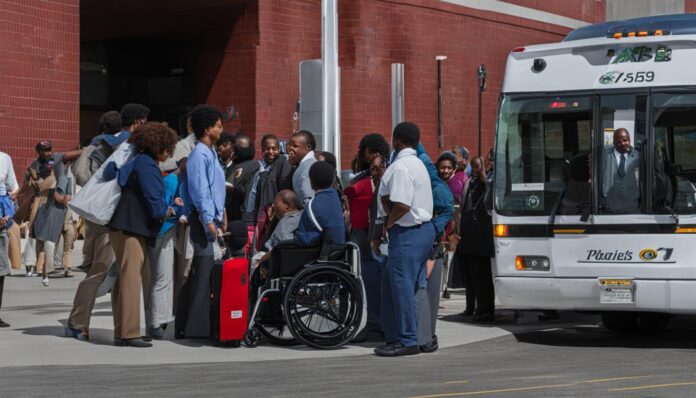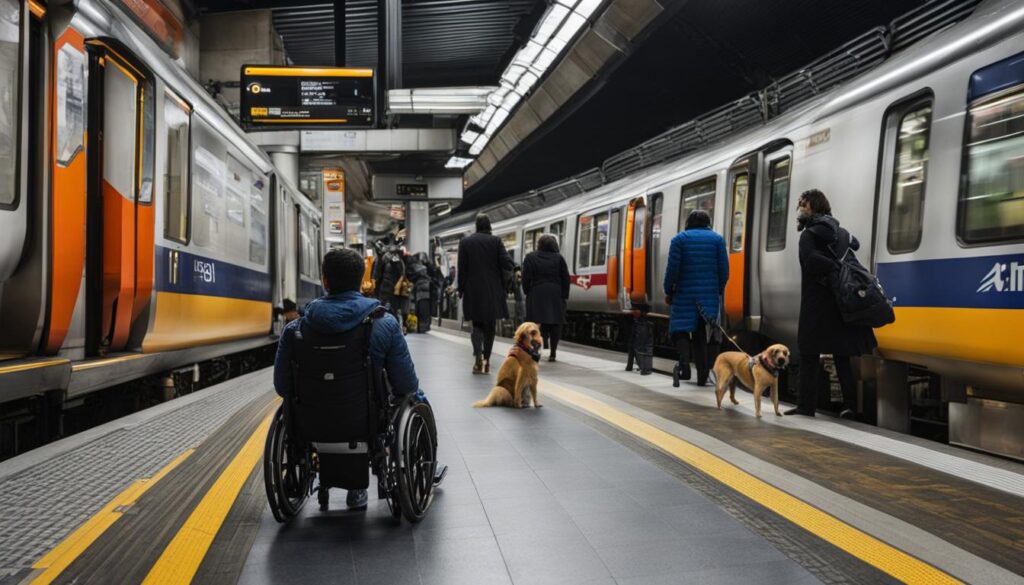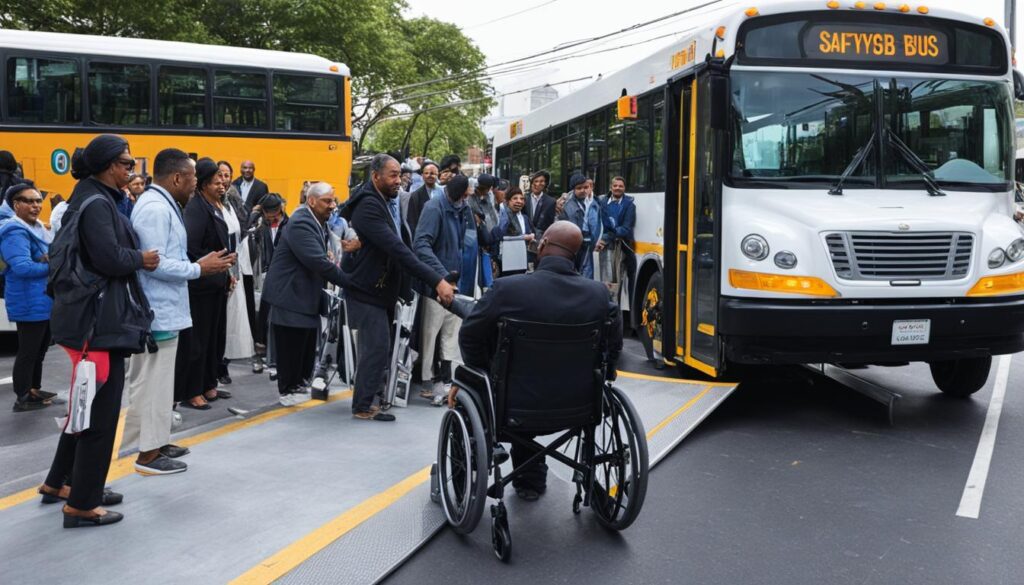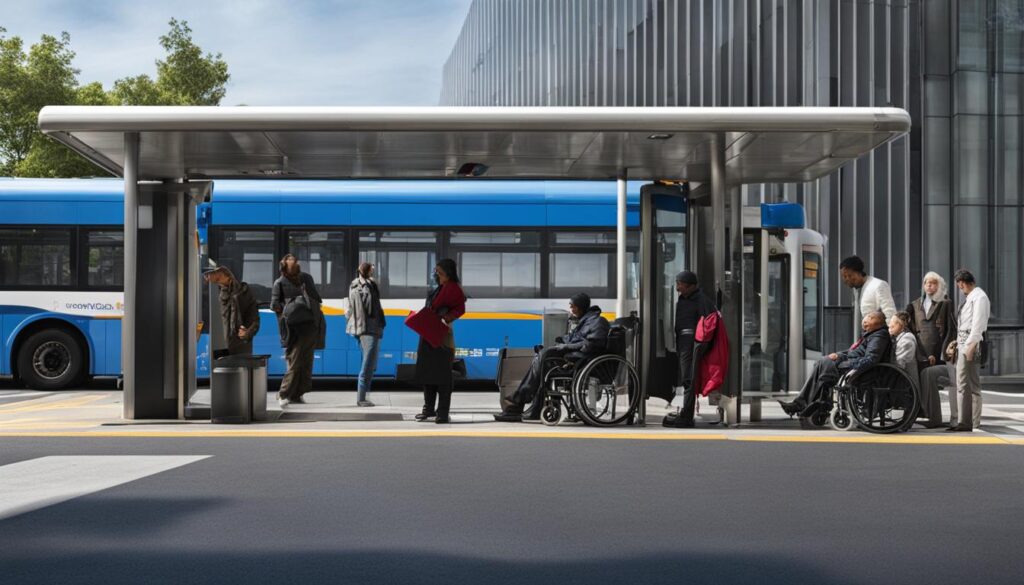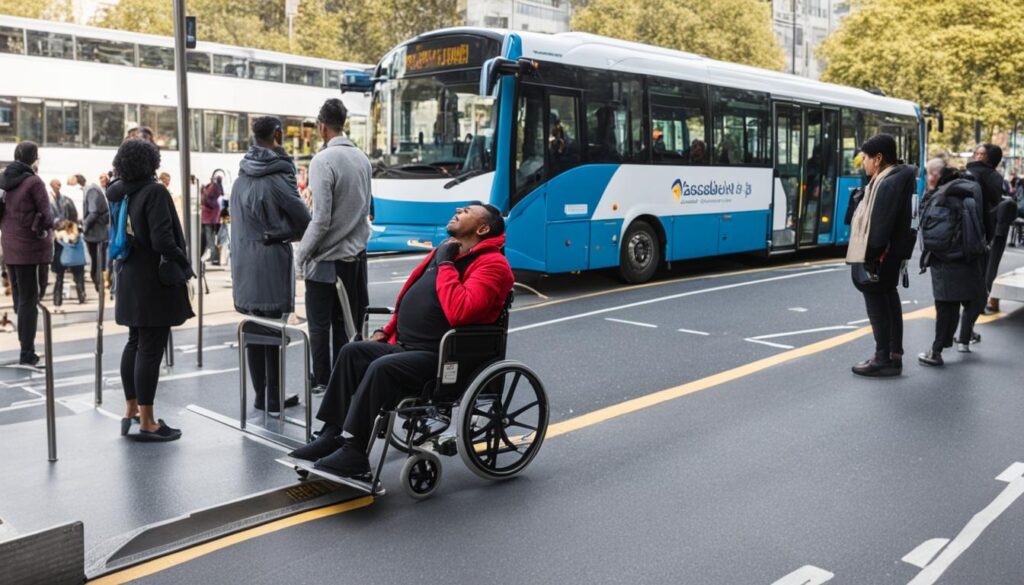Traveling by public transportation can be challenging, especially for individuals with disabilities. However, with a little preparation and knowledge of accessibility tips for travelers with disabilities using public transportation, it can be a smooth and empowering journey. In this section, we’ll provide you with essential accessibility tips to make your public transportation travel easier and more comfortable.
Whether you’re a frequent public transport user or just starting, it’s essential to understand how to navigate the system safely and efficiently. Following these accessibility tips can make a significant difference in your experience. Let’s dive in!
Understanding Public Transportation Accessibility Guidelines
If you have a disability, it is essential to know your rights when using public transportation. Accessibility guidelines and regulations are in place to guarantee that all travelers have the same opportunity to use public transportation.
The Americans with Disabilities Act (ADA) regulates accessibility in public transportation to ensure seamless travel experiences for individuals with disabilities. As per the ADA guidelines, public transportation must provide reasonable accommodations to individuals with disabilities. This includes accessible services, vehicles, and facilities.
| Accessibility Guidelines for Using Public Transportation with Disabilities |
|---|
| Use designated accessible entrances when boarding buses or trains |
| Reserve seats designated for individuals with disabilities, if available |
| Use accessible fare payment options, such as reduced fare programs and electronic payment methods |
| Request assistance if needed from transportation staff and fellow passengers |
In addition to the ADA, there are state-level accessibility guidelines and programs that travelers with disabilities can utilize to ensure a smooth journey. Familiarizing yourself with these guidelines and programs can help to alleviate anxiety and set realistic expectations for your travel experience.
When planning your trip, consider researching accessible routes, connecting stations or stops, and any necessary arrangements that must be made before your journey.
Image related to public transportation accessibility guidelines:

Planning Your Journey Ahead
When it comes to traveling with disabilities on public transportation, planning ahead is essential to ensure a seamless and stress-free journey. Here are some disability-friendly public transportation tips and accessible public transportation tips you can use to prepare for your trip:
| Tip | Why it’s important |
|---|---|
| Research accessible routes | Not all public transportation routes are created equal. Researching accessible routes beforehand can help you avoid potential accessibility issues and identify any necessary adjustments for your trip. |
| Check transportation schedules and trip duration | Ensure that the transportation schedules and required time to reach your destination are feasible, so you are not left stranded or unnecessarily exhausted. |
| Prepare any necessary documentation | If you need to travel with any documentation, such as a disability ID card or doctor’s note, have it on hand before your trip. |
| Communicate any special needs to transportation staff | By communicating your special needs to transportation staff in advance, you can request assistance and make any necessary arrangements, ensuring your trip is seamless and comfortable. |
By planning your journey ahead, you can minimize any potential challenges and make the most of your public transportation experience.
Remember, accessibility is a right, not a privilege. With these accessible public transportation tips and disability-friendly public transportation tips, you can have an empowering journey that allows you to travel confidently, independently, and with dignity.
Navigating Stations and Stops
Traveling with disabilities on public transportation can be challenging, especially when navigating stations and stops. However, with the right tips and knowledge, you can make your journey more comfortable and less stressful.
Using Ramps or Elevators
Many public transportation stations are equipped with ramps or elevators to assist travelers with disabilities. When arriving at a station, look for signs indicating the location of accessible entrances and assistive features.
If an elevator is not available, a ramp can be used as an alternative option for boarding. When using a ramp, make sure it is stable and secure before proceeding.
Identifying Accessible Entrances
Not all entrances may be accessible to travelers with disabilities. Look for signs indicating accessible entrances and exits, which are often located near elevators or ramps. If you are unable to find an accessible entrance, ask a staff member for assistance.
Locating Accessible Seating Areas
Accessible seating areas are designated for travelers with disabilities and can be located near doors or in designated sections of the vehicle. Look for signs or ask a staff member for assistance in locating these areas.
Summary:
- Use ramps or elevators to access stations
- Identify accessible entrances and exits
- Locate designated areas for accessible seating
Boarding and Exiting Safely
Boarding and exiting public transportation can be a challenging experience for travelers with disabilities, but there are several tips that can help you do so safely and with confidence.
Firstly, locate designated boarding areas indicated by signs or markers on the platform or stop. When boarding, wait for the vehicle to come to a complete stop and use the ramps or lifts if available to avoid any tripping or falling hazards. If you require assistance, request it politely from the driver or other staff members. Make sure that you position your mobility device or walker securely before moving to your seat.
As you approach your stop, be sure to signal the driver by pressing the request stop button or pulling the cord if available, as soon as possible. Plan your route in advance and memorize or write down the name of the stop to ensure a stress-free exit. Exits on buses are often located at the rear, while exits on trains are located toward the front or rear of each car.
Additionally, many vehicles feature accessible features such as handrails, priority seating, or audio and visual announcements to help you stay safe while traveling. Make use of these features and make sure you know how to operate them.
Understanding Public Transportation Etiquette
Using public transportation can be a convenient and affordable way for disabled individuals to get around. However, it’s important to understand proper etiquette to ensure a comfortable and safe experience for all passengers.
When using public transportation, it’s crucial to give up priority seating to individuals who need it, such as those with mobility impairments, pregnant women, and elderly passengers. This includes seats reserved for people with disabilities, marked with the universal accessibility symbol.
Being mindful of your space is also important, particularly if you have assistive devices like wheelchairs or walkers. Make sure to position your equipment in a way that doesn’t obstruct the aisle or doorway.
Communication is key when using public transportation. If you need assistance, don’t be afraid to ask the driver or a fellow passenger. You can also communicate your needs through non-verbal cues, such as pointing or gesturing, or by using a communication device if necessary.
Tip: Consider carrying a card with a message that outlines your specific needs and how others can assist you while using public transportation.
Remember to be respectful of other passengers and their needs as well. Avoid blocking seats with bags or other belongings, and keep noise levels down.
By practicing proper etiquette when using public transportation, you can help ensure a positive experience for everyone on board.
Using Accessibility Features on Public Transportation
Public transportation provides a variety of accessibility features to make travel easier for individuals with disabilities. Here are some useful accessible travel tips for public transportation:
Priority Seating
Many public transportation vehicles offer priority seating for individuals with disabilities or limited mobility. Look for designated seats that are marked with a disability symbol or are closer to the accessible entrances on buses, trains, or subway cars. If no designated seats are available, politely ask other passengers to give up their seats.
Tactile and Visual Cues
Accessibility features such as tactile and visual cues can help individuals with visual or hearing impairments navigate public transportation. Look for Braille signage or raised symbols for instructions or directions. Audio announcements and visual displays that show upcoming stops are also available on most modern public transportation vehicles.
Accessible Fare Payment Options
Public transportation systems offer accessible fare payment options for individuals with disabilities who may not be able to navigate traditional fare vending machines. These options include ticket agents, ticket vending machines with audio or touch screen features, or mobile fare payment apps.
Assistance Request Buttons
If you require assistance while traveling on public transportation, look for assistance request buttons that are usually located near the accessible seating areas or near the entrances. Pressing this button will alert the driver or staff to your request for assistance.
Communication Assistance
If you have difficulty communicating with transportation staff due to hearing or speech disabilities, consider carrying a communication card or using a mobile app that can translate your messages or speech to text. This can help you effectively communicate with staff and express your needs.
Service Animal Accommodations
Public transportation systems allow service animals to accompany individuals with disabilities on their journeys. If you have a service animal, ensure they are harnessed, leashed, or crated while on the vehicle to ensure safety for both the animal and other passengers.
By utilizing these accessible travel tips for public transportation, individuals with disabilities can navigate the system with ease and independence.
Communicating with Transportation Staff
Effective communication with transportation staff can make a huge difference in your travel experience. Whether you need assistance, have concerns, or require information about accessible services, here are some tips to help you communicate effectively:
- Speak clearly and calmly: When communicating your needs to transportation staff, speak clearly and calmly to ensure they understand you. Avoid rushing or getting frustrated, as this can make it difficult for staff to help you.
- Request assistance: Don’t be afraid to request assistance from transportation staff if you need it. They are trained to help passengers with disabilities and are there to support you.
- Report any issues: If you encounter any issues during your journey, such as broken accessibility equipment or inaccessible facilities, report them to transportation staff right away. This helps them address the issue and ensures that other passengers with disabilities will not face the same problem.
- Ask for information: If you have questions or require information about accessible services on public transportation, don’t hesitate to ask transportation staff. They have the knowledge and expertise to provide you with the information you need.
By using these tips, you can effectively communicate with transportation staff and make your travel experience more comfortable and enjoyable.
Navigating Transfers and Connections
Transferring between different forms of public transportation can be daunting, especially for travelers with disabilities. But with some careful planning and a bit of know-how, you can successfully navigate transfers and connections and reach your destination with ease.
Plan for Additional Travel Time
When planning your journey, it’s essential to factor in extra time for potential delays and unforeseen circumstances. Consider your route carefully, and check estimated travel times to give yourself plenty of time to make connections without feeling rushed.
Understanding Transfer Procedures
It’s crucial to familiarize yourself with the transfer procedures at each station or stop you’ll be using. Look for wayfinding signs that clearly indicate the location of accessible routes and elevators, and check if there are any steps or other barriers you need to be aware of.
Tip: If you’re unsure about your transfer procedures or have specific concerns, don’t hesitate to reach out to station staff for assistance. They’re typically happy to help and can provide you with the information you need to make your journey as smooth as possible.
Seeking Assistance if Needed
If you require additional assistance to make your connection, such as a wheelchair ramp or a helping hand with your luggage, don’t be afraid to ask. Many public transportation providers offer special services to passengers with disabilities, and there are often staff members available to provide assistance.
By taking the time to plan your journey, familiarizing yourself with transfer procedures, and seeking assistance when needed, you can successfully navigate transfers and connections on public transportation. Remember to stay patient, communicate your needs clearly, and take advantage of the accessibility features available to you.
Advocating for Accessibility Improvements
As someone who uses accessible public transportation tips, you have valuable firsthand experience that can help improve accessibility for all. Here are some ways you can get involved and advocate for accessibility improvements:
Contact Local Authorities
Reach out to your local government officials and transportation agencies to share your experiences and concerns. Ask what steps they are taking to improve accessibility and what you can do to help.
Share Feedback
Provide feedback to transportation providers and government agencies about their accessibility efforts. Highlight areas that are working well and suggest areas for improvement. Your feedback can help shape future policies and practices.
Raise Awareness
Spread awareness about accessibility issues by sharing your experiences and advocating for change. Use social media or other platforms to raise the visibility of accessibility barriers and encourage others to get involved.
Join Advocacy Groups
Join advocacy groups that focus on accessibility and transportation issues. These organizations can provide a platform for your voice and connect you with other advocates.
Remember, advocacy efforts take time and persistence, but they can make a real difference in the lives of travelers with disabilities. By advocating for accessibility improvements, you can help create a more inclusive and welcoming public transportation system for all.
Conclusion
Congratulations! You now have a wealth of essential accessibility tips and information to help you navigate public transportation with confidence and ease as a traveler with disabilities. By following the guidelines and regulations that oversee accessibility in public transportation, planning your journeys ahead, navigating stations and stops, safely boarding and exiting vehicles, understanding etiquette, using accessibility features, communicating with transportation staff, and advocating for accessibility improvements, you’ll be able to enjoy a seamless and empowering travel experience. Always remember that accessible public transportation is vital for ensuring equal opportunities for all members of our community. So, keep exploring, keep learning, and keep advocating for a more accessible future!




























